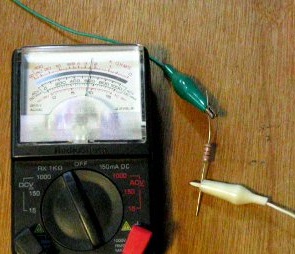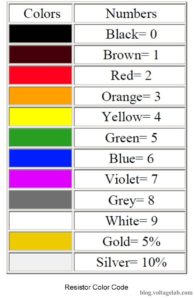Resistor Color Code Measurement is an essential skill for anyone working with electronics. In today’s digital world, digital multimeters have become the go-to tool for quickly and accurately determining resistor values. Whether you’re using a multimeter or decoding the color bands on a resistor, this guide will help you master both methods. With step-by-step instructions and tips, you’ll learn how to measure resistor values with precision, ensuring your projects run smoothly and efficiently.
Resistor Color Code Measurement
In this era, we all use digital multimeters. With the help of a digital multimeter, values can be easily obtained, and its accuracy is also excellent.
The value of a resistor can be determined in two ways.
- Using an ohmmeter / analog multimeter / digital multimeter.
- With the help of color code.
Resistor Color Code Measurement Using the meter
Ohmmeter and Analog Multimeter:
First, check if the needle of the meter is at zero adjustment. If not, use the zero adjustment screw to bring the needle to the zero position.
Then, set the selector knob of the meter to the Ohms position. Connect the two cables (probes) of the meter to the two terminals of the resistor. The meter’s needle will then give a reading, which will be the resistor’s value.

Using a Digital Multimeter:
This is the most commonly used meter in the present day. With this meter, values can be easily measured. First, set the selector knob to Ohms. Then, connect the two terminals of the resistor to the two probes of the meter, and the reading obtained will be the resistor’s value.

Resistor Color Code Measurement Using Color Code:
We can easily determine the value of a resistor using color codes. Now, the question is, what is a color code? The various colors marked on the body of the resistor are called color codes. Each color patch is called a band.
Resistors generally have at least four bands. Resistors with 5 and 6 bands are also available. A total of 12 colors are used for this purpose. The value of each color is given in the chart below.


Special Method to Remember Resistor Color Code:
A special method to remember the values in sequence.
In English: BB ROY Good Boy Very Good Worker
BB B = Black (কালো) B=Brown()
ROY R=Red, O=Orange, Y=Yellow
GoodG=Green
BoyB=Blue
VeryV=Violet
GoodG=Gray
WorkerW=white
Now, let’s see the simple method of determining values
We will write the value of the 1st color, the 2nd color, and the number of zeros according to the 3rd color, and the 4th color is usually gold or silver.
The 4th color band is considered tolerance. You may ask, what is tolerance?
Tolerance is only gold or silver. The last band of the color code is tolerance, which balances the value of the resistor. Many of us are familiar with the concept of error. When we measure a value, it might not always be exact due to various reasons.
Similarly, in the case of a resistor, the value can vary due to temperature. The tolerance range indicates how much the value may vary (+/-). Hopefully, the following example will clarify this.
Example: Suppose the colors on a resistor are Yellow, Violet, Brown, and Gold
So, for Yellow, we will write 4
For Violet, we will write 7
For Brown, it’s 1, so 1*10=10
Gold Tolerance (+-5%)
The value of the resistor will be, 47*10=470 Ohms or 470/1000=0.47 Kiloohms.
Example 2: Green, Blue, Orange, Gold
Green=5, Blue=6, Orange= 1*1000=1000, Gold= +-5%
The value will be=56*1000=56000 Ohms, and the tolerance or possible variation in value is +-5%
To convert to kiloohms, 56000/1000=56 Kiloohms.
How Values Are Written:
Previously, values were written as 50Ω, 60KΩ, 1MΩ. But now they are written as 50R, 60K, 1M. Here, R stands for Ohms, K stands for Kiloohms, and M stands for Megaohms.
What is a resistor color code calculator?
A resistor color code calculator is a tool that helps you determine the resistance value of a resistor by inputting the color bands marked on the resistor. It simplifies the process of reading resistor values based on their color codes.
How does a 5-band resistor color code calculator work?
A 5-band resistor color code calculator allows you to input the five color bands on a resistor to find its precise resistance value. The additional band provides more accuracy in resistance measurement compared to a 4-band resistor.
What is a resistor color code chart?
A resistor color code chart is a reference guide that displays the values associated with each color on a resistor. It helps in manually decoding the resistance by matching the colors of the bands to their corresponding numerical values.
How does a 4-band resistor color code calculator work?
A 4-band resistor color code calculator lets you input the four colors on a resistor, and it outputs the resistance value. It’s commonly used for standard resistors where the first two colors represent digits, the third is a multiplier, and the fourth shows tolerance.
How do you read a resistor color code?
To read a resistor color code, follow these steps: Identify the number of bands on the resistor (usually 4, 5, or 6).
The first two or three bands represent significant digits.
The next band is a multiplier, and the final band indicates tolerance.
Use a resistor color code chart or calculator to convert the colors into numerical values.
What is a resistor?
A resistor is a passive electronic component used to limit or control the flow of electrical current in a circuit. It has a fixed or variable resistance value, which is measured in ohms (Ω), and helps manage the voltage and current in a circuit.



